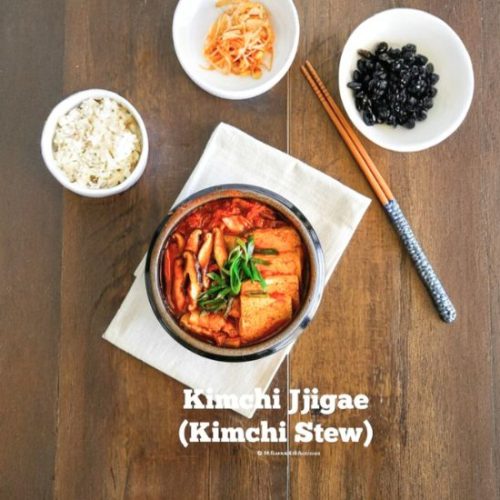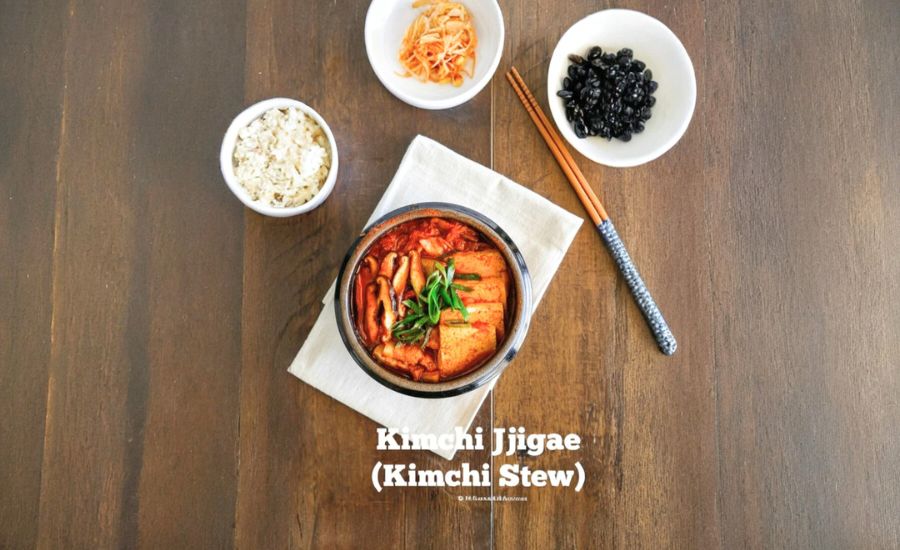All products are selected by our editorial team for quality. If you buy through our links, we may earn a small commission at no extra cost to you.
Kimchi Jjigae is a quintessential Korean stew that shines with its bold, tangy flavors and comforting warmth.
What makes this recipe truly special is the use of aged kimchi, which adds a deep, fermented complexity that balances the richness of tender pork belly and the silkiness of tofu.
Nutritionally, this dish is a great everyday choice because it offers a high-protein content from pork and tofu, moderate healthy fats, and a low carbohydrate count, making it satisfying yet balanced.
Additionally, the inclusion of shiitake mushrooms and green onions contributes fiber, vitamins, and antioxidants.
This stew is quick to prepare, usually ready within 30 minutes, making it ideal for busy weeknights or meal prep.
Its hearty nature, combined with bold Korean spices like gochugaru and gochujang, satisfies cravings while keeping you nourished and energized.
Perfectly paired with rice, this stew brings both comfort and nutrition to your table, making it a must-try staple for anyone seeking authentic, flavorful Korean cuisine at home.
Must-Have Tools for Perfect Results
Clay Pot (Dolsot or Ttukbaegi)
Perfect for cooking kimchi jjigae as it retains and distributes heat evenly, allowing the flavors to meld beautifully while keeping the stew hot during serving. Beyond this recipe, it’s essential for any Korean-style stews and rice dishes, adding authenticity and efficiency in your kitchen.
Staub Cocotte (7-inch Dutch Oven)
This versatile enameled cast iron pot excels at slow cooking and simmering, making it a reliable choice for stews, soups, and braises. Its excellent heat retention ensures even cooking and flavor development, suitable for countless recipes beyond kimchi jjigae.
Skillet or Sauté Pan
Used for softening the kimchi before adding it to the stew, this pan is a kitchen workhorse for searing meats, sautéing vegetables, and enhancing flavors in any savory dish. A non-stick or stainless steel skillet is a valuable all-around tool.
Sharp Chef’s Knife
Essential for prepping ingredients like pork belly, mushrooms, tofu, and vegetables with precision. A good-quality chef’s knife improves safety, efficiency, and presentation for all your cooking adventures.
Measuring Spoons and Cups
Accurate measurement of ingredients like gochugaru, soy sauce, and rice wine is crucial for balanced flavors in this recipe. Reliable measuring tools ensure consistency and success in both simple and complex recipes.

30-Minute Classic Korean Spicy Kimchi Stew
Equipment
- 1 clay pot (or 1.5-liter capacity pot/Dutch oven)
- 1 skillet or sauté pan
- 1 Sharp Chef’s Knife
- Measuring Spoons (set)
- Measuring cups (set)
Ingredients
Protein & Meat
- 180 g about 0.4 lb skinless pork belly, cut into bite-sized chunks
- 1 tablespoon sweet rice wine mirin
- A pinch of freshly ground black pepper
Kimchi & Vegetables
- ¾ cup well-fermented kimchi aged 2–3 weeks, chopped if needed
- ¼ small brown onion about 30 g, thinly sliced
- ½ small green onion stalk about 5 g, finely sliced
- 2 fresh shiitake mushrooms around 50 g, stems discarded and sliced thin
- 150 g firm tofu about 5.3 oz, cut into 1 cm thick pieces or preferred shapes
Broth & Seasoning
- 1 cup water 250 ml
- 1 tablespoon Korean chili powder gochugaru
- 1 tablespoon soy sauce
- 1 teaspoon Korean chili paste gochujang
- ¼ teaspoon minced garlic
- A few cracks of black pepper
Instructions
- Marinate the Pork Belly: Begin by combining the pork belly pieces with the sweet rice wine and a pinch of ground black pepper.Toss well to coat evenly and let it rest for 15 minutes to develop flavor and tenderness.
- Soften the Kimchi: In a skillet over medium heat, gently cook the chopped kimchi until it becomes soft and aromatic, about 3-5 minutes. This step enhances its flavor and mellows the acidity. (Alternatively, you can do this directly in the stew pot if it’s roomy enough.)
- Assemble Ingredients in Pot: In a medium-sized pot (such as a clay pot or heavy-bottomed Dutch oven), place the marinated pork belly at the bottom. Add the softened kimchi on top, then layer the sliced brown onion, shiitake mushrooms, tofu, and pour in the water.
- Mix and Add Seasonings: In a small bowl, whisk together the gochugaru, soy sauce, gochujang, minced garlic, and black pepper. Pour this seasoning mixture into the pot and gently stir to combine all ingredients evenly without breaking up the tofu.
- Simmer to Perfection: Place the pot over medium-high heat and bring the stew to a boil. Once boiling, reduce the heat to medium-low and let it simmer gently for 10 to 15 minutes. Occasionally spoon the broth over the ingredients to help the flavors meld evenly and ensure the pork is cooked through.
- Finish with Green Onion: Just before serving, stir in the sliced green onion for a fresh pop of flavor and color. Give the stew one last gentle stir, then remove from heat.
- Serve Hot: Ladle the kimchi jjigae into bowls and serve immediately, ideally alongside steamed rice and traditional Korean side dishes for a complete meal.
Notes
- Kimchi Choice: The depth of flavor depends on using well-aged kimchi—aim for kimchi that’s been fermented for at least 2-3 weeks for a robust, tangy stew.
- Tofu Texture: Firm tofu works best here to hold shape during cooking, but feel free to use medium firmness if preferred.
- Pot Options: A clay pot gives authentic results, but any medium-sized heavy pot or Dutch oven works well. Make sure it’s large enough to stir comfortably.
- Spice Level: Adjust the gochugaru and gochujang amounts to your preferred spice level—start with less if you prefer milder heat.
- Storage: Refrigerate leftovers in an airtight container for up to 3 days. Reheat gently on the stove to prevent tofu from breaking apart.
Chef’s Secrets for Authentic Flavor
Achieving an authentic kimchi jjigae starts with using well-aged kimchi, which brings a deep, tangy complexity to the stew that fresh kimchi simply can’t match.
Marinating the pork belly with sweet rice wine and black pepper not only tenderizes the meat but also balances the stew’s bold flavors.
Cooking the kimchi separately before adding it to the pot enhances its softness and mellow acidity, making the stew smoother and more harmonious.
Stirring gently to avoid breaking the tofu preserves its silky texture, while spooning broth over the ingredients during simmering ensures every bite is infused with rich flavor.
Using a clay pot or a heavy-bottomed Dutch oven promotes even heat distribution, allowing the stew to cook perfectly and stay piping hot when served.
Serving Suggestions to Impress Guests
Kimchi jjigae pairs beautifully with steamed white rice, which helps mellow the stew’s spiciness and brings a satisfying balance to the meal.
For a traditional Korean experience, serve it alongside a variety of banchan—small side dishes like pickled radishes, seasoned spinach, or mung bean sprouts.
Adding a simple fried egg on top of the rice can add richness and make the meal even more filling.
For those who prefer a milder palate, a refreshing cucumber salad or a glass of cold barley tea complements the stew perfectly.
This dish is excellent as a centerpiece for a cozy family dinner or casual dinner parties where guests can enjoy the communal warmth of sharing a hearty stew.
Storage Tips to Preserve Freshness
Leftover kimchi jjigae should be stored in an airtight container and refrigerated promptly to maintain its flavor and freshness.
It keeps well for up to three days and can be gently reheated on the stovetop to avoid breaking the tofu or drying out the pork.
For longer storage, freeze portions in suitable containers for up to one month; just thaw overnight in the refrigerator before reheating.
Avoid microwaving directly as it can unevenly heat the stew, potentially altering its texture.
If the stew tastes overly intense after refrigeration, adding a splash of water or broth while reheating can help mellow the flavors without diluting the essence of the dish.
Frequently Asked Questions Answered Clearly
1. Can I use other types of meat instead of pork belly?
Yes! While pork belly adds rich flavor and fat, you can substitute with pork shoulder or even chicken thighs for a leaner option. Just adjust cooking times accordingly to ensure tenderness.
2. What if I don’t have aged kimchi?
Using freshly made kimchi will work, but the stew won’t have the same depth of flavor. You can compensate by cooking the kimchi longer or adding a small amount of vinegar or fermented seasoning for tang.
3. How spicy is kimchi jjigae?
The dish is moderately spicy thanks to gochugaru and gochujang, but spice levels can be adjusted easily by reducing or omitting these ingredients to suit your taste.
4. Can I make kimchi jjigae vegetarian?
Absolutely. Replace pork with extra tofu or mushrooms, and use vegetable broth instead of water for added depth. You can also add other veggies like zucchini or potatoes.
5. Is kimchi jjigae healthy?
Kimchi jjigae is nutrient-rich, featuring probiotics from fermented kimchi, protein from pork and tofu, and antioxidants from mushrooms and vegetables. However, it can be high in sodium, so moderation is key.
This recipe is inspired by mykoreankitchen and has been carefully refined to enhance clarity, streamline preparation steps, and ensure accurate results. We’ve also included health benefits, nutritional highlights, and Must-Have Tools to help you get the best results every time you cook.


